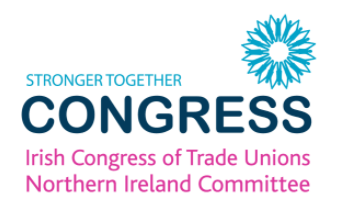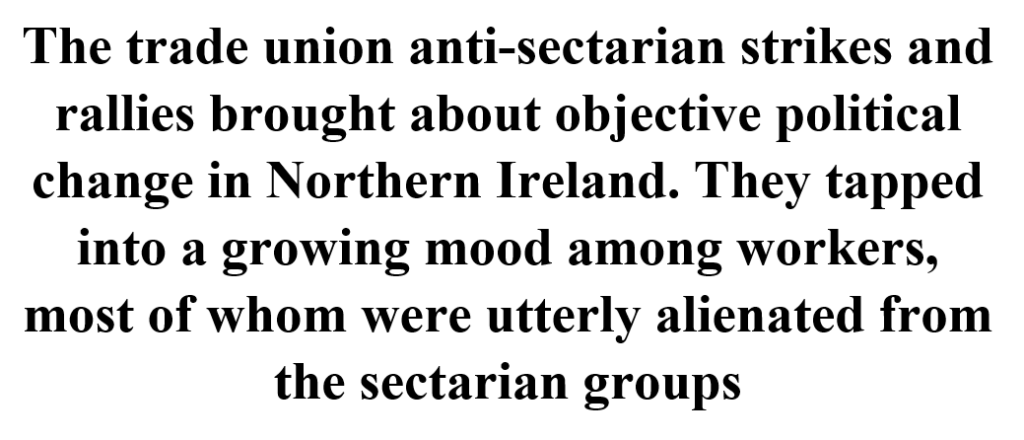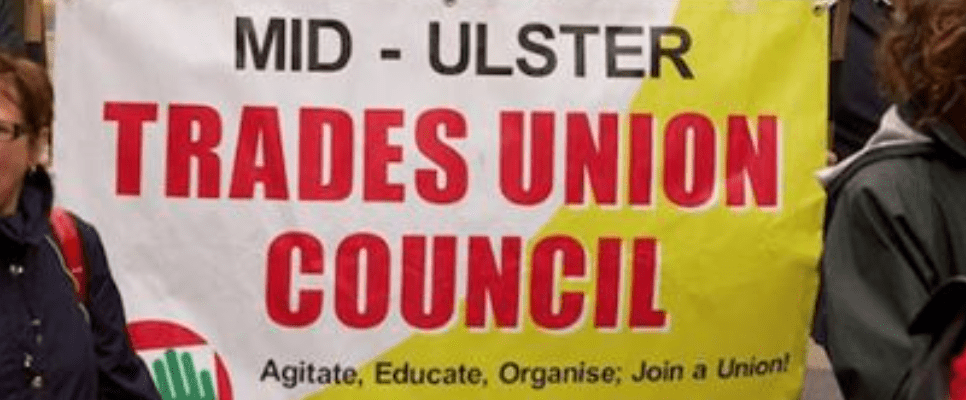By Harry Hutchinson, Mid Ulster Trades Council.
This month marks the thirty year anniversary of the milestone campaign of the Mid Ulster Trades Council against sectarian violence in Northern Ireland. It was the kind of workers’ campaign that has received scant credit since then, but which provided such political momentum that the Good Friday Agreement inevitably followed from it.
As the 1990s followed on from the 80s, there was a renewed upsurge in sectarian conflict in Northern Ireland. The Provisional IRA were becoming more sophisticated in their attacks against British forces and along the Irish border, in their stronghold of Crossmaglen, they used snipers to kill eight British soldiers. They had developed the military capability to bring down army helicopters and were targeting the British mainland, such as the mortar attack against 10 Downing Street.
But it was civilians that had always borne the brunt of the casualties in the conflict. The 1989 Enniskillen bomb, for example, was left by the IRA at the cenotaph in that town, killing nine civilians and one RUC officer. Such attacks were reciprocated by Loyalist paramilitaries killing random Catholics.
Mid Ulster Trades Council decided to launch campaign
In January 1992, construction workers were returning home from working at the RUC barracks in Omagh, Co Tyrone, when a roadside bomb installed by the IRA exploded, killing eight of the workmen and injuring several others. That became known as the Teebane Massacre, after the location in Mid Ulster.
It was then that members of the Mid Ulster Trades Union Council (MUTC) decided to respond to the massacre and called for a strike of workers in two of the main towns in the area, to protest against sectarianism. The strike was called to unite workers, Catholic and Protestant, against all violence, by Republicans, Loyalists, and also the State. The Trades Council urged the Northern Ireland Committee of the Irish Congress of Trade Unions (NIC/ICTU) to back the strike.

The reaction of the NIC/ICTU was to distance itself from supporting the strike. The Assistant General Secretary, Terry Carlin, even went on radio and TV claiming the MUTC did not represent workers in the area and he refused to back the strike.
However, pressure was building on the NIC/ICTU leadership. The Trades Council in Mid Ulster had members in many key workplaces in the area, one being UNIPORK, a pig factory in Cookstown and the biggest employer in the area. In the adjacent town of Magherafelt, two representatives sat on the Trades Council from the Peter England shirt factory, employing 300 workers. The civil service union NIPSA had one Trades Council rep from the area.
In the days running up to the planned strike, it was in the balance. Workplace union reps reported that some of the workforce were prepared to respond to the strike call, but it was not possible to determine how many. Scab trade union reps attempted to undermine the strike by reporting that there was ‘no mood’ for action, but other reps reported differently.
NIC is a potentially powerful organisation with great authority
It was only members of NIPSA who remained resolute to fully back the strike. These workers had already gone on strike themselves, after threats from loyalists. But still, the success of the strike looked like it depended on backing from the Northern Ireland Committee of the ITUC. This is potentially a very powerful organisation of over thirty unions, representing 200,000 workers, and its voice would carry a lot of authority in workplaces.
On the eve of the strike, NIC/ICTU sent a circular for all MUTC members and union reps in Mid Ulster to attend a meeting in a hotel in Cookstown. I still recall Carlin’s voice on the phone: he was clearly under pressure to back the strike and he assured me the matter would be sorted at the meeting.
At the meeting, the NIPSA rep spoke first, commending the work that the MUTC had done, to have brought the planned strike this far and calling on NIC/ICTU to give the strike their official support. It became clear that the refusal of the NIC/ICTU to back the strike was becoming untenable. Carlin finally proposed that the NIC/ICTU would call on all workplaces to support the strike and that the NIC/ICTU would organise the rally points.
Forcing the NIC into action was in itself a significant advance towards a workers’ movement that was against sectarian paramilitary and state killings. It demonstrated what one small trades council could achieve with a clear political programme based on workers’ unity.
Called on trade union movement to throw its weight against sectarianism
The following day, 1,500 workers left their workplaces in Cookstown and another thousand in Magherafelt, marching to rallying points in the town centres. Carlin and I addressed the rallies. The MUTC called on the trade union movement to throw its full weight against the sectarian paramilitaries and to go on the offensive to tackle political divisions and the poverty on which the paramilitaries feed.

The Mid Ulster strike proved a turning point, but more was to come. Soon afterwards, a bomb planted in a bookie’s shop by the Ulster Defence Association killed five Catholics. The NIC/ICTU were forced to follow the example set by Mid-Ulster TC and begin to speak out and organise against the paramilitaries. They organised a rally at Belfast City Hall, attended by 20,000 workers, in what was one of the largest rallies recorded in the city.
The trade union anti-sectarian strikes and rallies brought about objective political change in Northern Ireland. They tapped into a growing mood among workers, most of whom were utterly alienated from the sectarian groups and who felt nothing but revulsion for the sectarian killings of ordinary working people. The unions had demonstrated concretely that workers were able to unite and to isolate the paramilitaries and wanted to move on from the violence of the past towards a new era in Northern Irish politics.
Leaders of capitalist parties like to claim the credit
Talks between the British Government and Sinn Fein had already commenced as this ‘war weariness’ became more expressed in public opposition to violence, so 1994 saw an IRA ceasefire and further talks that would eventually lead up to the Good Friday Agreement. The leaders of the capitalist parties in Northern Ireland, like their counterparts in the South, in Britain and in the USA, like to credit themselves for bringing change to the region, but they downplay the role of the workers’ movement that so forcefully expressed the growing opposition to sectarianism.
The underlying problems of sectarianism and poverty still remain. For most ordinary workers, especially young workers, there has been no ‘peace dividend’. There is still, unfortunately, the potential of a resurgence of sectarian violence. These same capitalist parties who like to claim the credit for the current (relative) peace, have nothing to offer workers in the long run but division.
The workers’ strikes in Mid Ulster and later in Belfast demonstrated the effect that ordinary working class people can have on moving society forward. During this period when the Mid Ulster Trades Council were campaigning, other trades councils and trade union groups were taking up the same call. These events show that it is the trade union movement, organised around a socialist programme, that could unite workers in the North and in the South and provide the base for a new beginning for Ireland.



